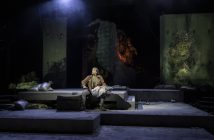My first introduction to King Lear was at a school play. My brother, who sits beside me at the Barbican this evening, took the lead role in an abridged version of the play, aged 7, in a regal red fluffy dressing gown that lingered in our house for a good few years. “I don’t remember your mad scenes”, I say to him before the play starts, “I had to sing…” he replies in a muted tone. Suffice to say this production is a little different.
Featuring a company of 22, this Lear is impressive in scale from the outset. A full stage in the opening scene gives a sense of the pomposity of Lear’s court, richly adorned with furs and silks, and a stony collective of men. It is visually striking and the live music on stage creates an authentic sense of the court. Lear is carried on stage at a stately pace inside an oversized clear box – a recurring motif that features throughout the play and perhaps brings to life the plays key themes of seeing, being seen and ultimately everything being not quite as it seems. Most harrowingly we see the clear box as a quasi-torture chamber when Gloucester has his eyes plucked out, blood spraying and being smeared across the interior.

In many of the plays great moments we see Lear lifted aloft as if to bring him closer to the heavens he so often calls upon. This is a very pagan production at many times, the gilded sun and moon a feature in the opening scene to the low rumble when Lear holds his hands aloft and rails down curses on his daughters. However this felt particularly underwhelming in the storm scene when intense pyrotechnics, some rippling fabric and a raised platform felt a poor backdrop for such a pivotal moment.
The play is boldy minimalist, to the point that at times I felt myself lost in both time and space – where are we now? The heath? A castle? Within? Without? It’s often unclear. The stark white of the heath, opening from within the brick interior felt almost beautifully heavenly but the use of shadow to denote the battle felt contrastingly amateur. The monochromatic colour scheme ironically helps to add a defined sense of light and shade. In the first half, we see only the Fool and Cordelia as one in white (an interesting line of critical analysis often intimating that they could be seen as one and the same, given Lear’s relationship with them, and would likely have originally been played by the same young actor) . The second act brings others down in to white too, the frailty and inwardness, and perhaps also newfound purity, of both Gloucester and Lear now within this realm too.
Sher’s reading of the character is both powerful and vulnerable, intimidating and diminutive. Shedding his furs in the second act, he cuts a small silhouette compared to many others on stage, his bushy beard belying the fear and loneliness of a previously great figure. His relationship with Graham Turner’s Fool shows a great sense of the private person behind the public face as they share genuine emotion and humour, rather than the anguish of a public persona. His madness is not mania, nor disdain, but a sense of disillusion and acceptance that is silently tragic.

Mention must also be made of David Troughton, Oliver Johnstone and Paapa Essiedu, whose rendition of ‘The Gloucester Family’ is one of the most conflicting I’ve seen. Essiedu’s Edmund is suave, instantly likeable and compellingly watchable despite his sinister plans. While Johnstone’s Mad Tom is one of the finest I’ve seen and his relationship with his blinded father left tears rolling down my cheeks. The brilliance of these father-children relationship (mirroring Lear’s own) are highlights of this production.
The stage is minimalist, stripped back and at times almost vacuous. One could argue that Gregory Doran has done too much to simply rely on the strength of the play itself, but too little to make the creative angle and take on the play clearly defined. The acting is moving, the costumes sumptuous, the rendition heart wrenchingly tragic, but the staging and setting at times is left a little wanting.
King Lear at the Barbican, until 23rd December 2016. For more info and tickets, visit the website.




